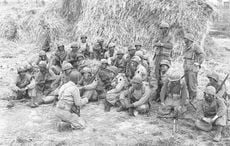Today, Sunday, October 28, marks the International Commemoration of the Great Irish Famine.
In honor of the International Commemoration of the Great Irish Famine taking place today in Melbourne, Australia, we look back on the remarkable story of New Yorker Bill Fahey.
In 2017, during the 150th anniversary of the worst year of the Irish Great Hunger, Black ‘47, commemorations took place across the US in memory of both those who died in Ireland of famine and disease and those who made the tortuous journey across the Atlantic, only to have their American Dream cut short on US shores.
The memorial events were inspired by the grit and determination of 89-year-old New Yorker Bill Fahey who has worked with the Ireland-based group the Committee for Commemoration of Irish Famine Victims (C.C.I.F.V.) to create the International Hunger markers project, which has planted memorials in US states and throughout Ireland to identify the often unmarked graves of thousands of Irish famine victims.
The project aims to mark all unmarked famine graves wherever they are found - on the Island of Ireland, its islands, and any locations overseas - as an affordable and easy way to respectfully remember all unmarked famine grave sites.
“These people were dehumanized and to leave them in the ground with nothing over them was terrible, especially as they were innocent,” Fahey, whose mother and father hail from Laois and Mayo respectively, told IrishCentral
“They weren't doing anything and it seemed like nobody cared about them.”

Bill Fahey shares the vision of his historical Great Hunger Remembrance Stone Marker project that he has developed. Image: Irish Railroad Workers Museum.
Referring to what he believes as the “conspiracy of silence” surrounding much of the history of the famine in Ireland, Fahey tells of his determination to research as much as possible about the country and the time, traveling to Ireland to spend days in National University of Ireland, Maynooth, and the National Library looking at exports of food from the country in the 1840s.
“They [the Irish government] don't want anybody to know about these things,” he claims, “and we should remember these people because they were great people.
“They could have had food and aid and everything else if they gave up their faith but they didn’t,” Fahey continues, referring to the practice of soup kitchens run by non-Catholics during the famine years to encourage starving people to renege on Catholicism in exchange for food.
“These are our family ancestors and we should ever forget what was done to them.”
“What’s the matter with the Irish people?” he asks, questioning what Irish politicians were doing when groups such as C.C.I.F.V. were campaigning for a national day of commemoration for the Great Hunger over the past number of decades.

Irish American historians and activists - Denny Lynch and Bill Fahey. Image: Irish Railroad Workers Museum.
The national set day of remembrance is now to begin in 2018, after years of campaigning by those who expressed their dismay and frustration at this culture-changing event in Irish history being left to the wayside, as they saw it.
Unfortunately, the date chosen by the Irish government may disrupt the plans of some of the commemoration’s most loyal organizers across the US, as the disparity between Mother’s Day in Ireland and the US comes into play.
Now officially assigned as the second Sunday in May, the national day of commemoration will be in conflict with the US Mother’s Day, making programming more difficult for the likes of the Baltimore Irish Railroad Workers Museum, who, in collaboration with local divisions of the Ancient Order of Hibernians, hold an annual remembrance event.
Last weekend, Fahey drove from New York to Baltimore where the museum was erecting another one of his marker stones in St. Peter’s Cemetery.
“He's just so dedicated and so committed,” Michael Mellett, President of the Board of Directors for the Museum, enthuses of Fahey. Having held a commemoration in the museum backyard since at least 2009, the museum now plans to incorporate the marker into events in the future, while they still have a further two markers from Fahey to place in other local cemeteries with large Irish populations.

Great Hunger marker in St. Peter's Cemetary, Baltimore. Image: Irish Railroad Workers Museum.
Celebrating the lives of James Feeley and his wife Sarah Feeley (neé Liberty), both born in Tipperary, the Baltimore Irish Railroad Workers Museum exhibits in two houses of the “Lemmon Street Five”, a row of houses in the Hollins Market area of Baltimore occupied by Irish immigrants working on the Baltimore Ohio railroad.
Billing themselves as “the biggest little museum in Baltimore,” with thanks to their extensive and impressive programming for such little funding, the museum plan to launch a capital campaign this June to buy back the remaining houses along the row which they were forced to give up in order to keep the project rolling. Now set to celebrate their 20th anniversary this June 17 with an event in their backyard alongside the Famine Irish tribute wall, they will launch a bid to raise $1 million to make themselves less of a little museum.
“Most of the parish was Irish,” said Mellett of St Peter’s, where the museum is located and in which cemetery the famine marker is placed.
“It was a real working-class Irish immigrant neighborhood, mostly working at the railroad and associated industries.
“Just walking through that graveyard is spectacular because there are 6ft-, 8ft-, 10 ft-high obelisks that are just beautifully chiseled, with angels chiseled out of the marble and beautiful scenes. There's even one of a boat, a ship, it's just a gorgeous place.”
Read more: Exploring the life of an Irish railroad family at the Baltimore Shrine to the Immigrant Irish

Museum docent and Irish American activist Kathy Kelly and the indefatigable Bill Fahey pose with the Grave Marker of the Reverend Edward McColgan who led St Peters Church for over 56 years after its birth in 1843 to serve the Irish and others in 19th century west Baltimore. Image: Irish Railroad Workers Museum.
The museum was fortunately given carte blanche with the site they chose for the marker by Jonah House, a community activist group who now oversees St. Peter’s Cemetery. Placed in a beautiful spot between two trees and in a great green space, Mellett hopes that the museum will be able to continue to bring tours to the remembrance spot, sharing the cemetery with those visiting the famous peace activist and former Roman Catholic priest Philip Berrigan, who is also buried here.
This Sunday, the markers’ creator Fahey will also travel to Staten Island where they will hold their own Great Hunger commemoration with music from Redbrick Duo before the official ceremony kicks off at 2 pm. Organized by Friends of Abandoned Cemeteries and held annually on the grounds of the NYC Marine Hospital Quarantine Station, one of Fahey’s famine markers was erected on the site in 2015. The marker in Staten Island was, in fact, the first to be erected in a US city.
During the years of the Great Irish Famine (1845-1858) tens of thousands of Irish Immigrants came to New York Harbor, many of whom were found with disease and perished. The Marine Hospital and Quarantine Station operated on Staten Island from 1799 until 1858, checking all those who came into New York harbor for signs of disease before being let ashore.

The marker in Staten Island.
The hospital saw many casualties among the Irish who braved the perilous voyage across the Atlantic in search of safer shores and the medical center came to operate two cemeteries to cope with the mass of deaths among starving and weak Irish immigrants.
Those who died were buried on Staten Island, no death certificates were issued, no cemetery log kept, and gradually the burial sites disappeared from all further records.
*Originally published in May 2017.




Comments